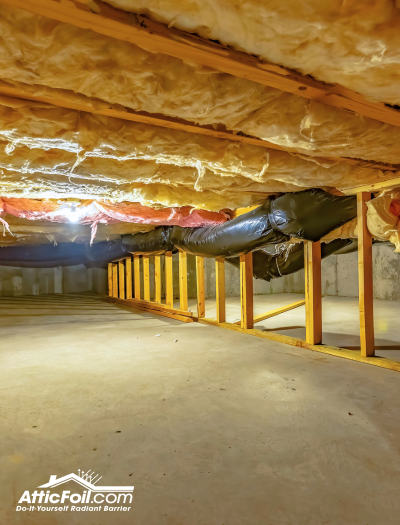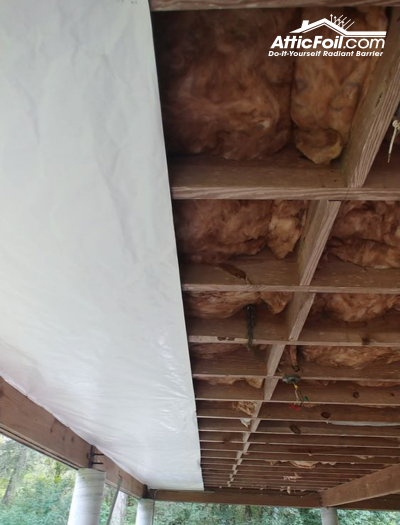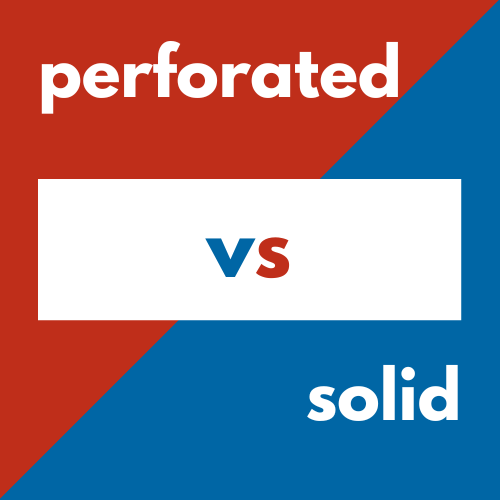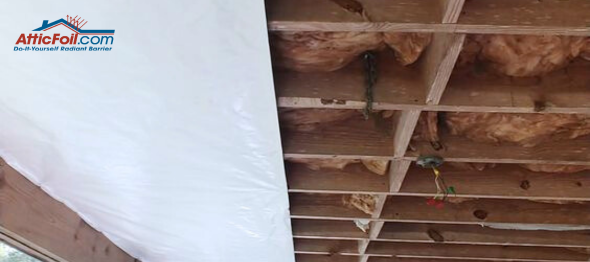Using AtticFoil™ radiant barrier in a crawlspace
Other than heat retention, there really is no added benefit to using a radiant barrier in a space that does not have a regular source of radiant heat.
That being said, using a radiant barrier foil in a crawlspace is beneficial if you are losing heat in the wintertime through the floor of the house into this crawlspace; if the heat is radiating across the air gap from the flooring to the ground outside, then AtticFoil™ can help reduce that heat loss. You would use AtticFoil™ Radiant Barrier in crawlspaces to help protect against heat loss from the floor above into the crawlspace.
If you do not have a vapor barrier in the crawlspace and it is open to the earth below, you can use AtticFoil™ Radiant Barrier Vapor Barrier to stop moisture and help retain heat in the floor above.
AtticFoil™ is tear-proof, so adding it to a crawl space can help with critter control.
TIP
When installed with the proper air gap, AtticFoil™ Radiant Barrier will stop 97% of radiant heat loss from the floor above the crawlspace.
Converting Vented Crawl Spaces to Sealed Crawl Spaces
In the past it was common to build homes with ventilated crawlspaces, because it was thought that outside air would help control moisture problems in a crawlspace. While it is true that ventilation helps moisture dry out, it’s been found that in this environment this is not always the best practice.
Introducing warm air to a cool environment (or vice versa) creates the conditions necessary for condensation, which is typically the root of the problem in a damp, moldy crawlspace. To address this, we have seen the introduction of sealed crawlspaces and crawlspaces that utilize a vapor barrier in order to stop moisture from the ground from coming up into the home.
As a first option we recommend sealing the crawlspace and making it semi conditioned space. Doing this has many benefits, including controlling the humidity/moisture and the temperature of the crawlspace. However, sealing a crawlspace can be labor-intensive and costly. As an alternative, we recommend using radiant barrier technology to achieve similar results.
Step 1: Insulate First
Because the application is below a conditioned space, you want to utilize both radiant barrier and traditional insulation. You can use foam board, spray foam or traditional batt insulation to fully insulate your floor joists. A can of spray foam can help seal up any gaps/cracks before you insulate and will help hold heat in too.
Products like foil-fiberglass and bubble foil aren’t really best used in this application, since you need maximum R-value and the reflectivity of a radiant barrier. You will get the best return on your investment if you buy the radiant barrier and the traditional insulation separately and then combine them yourself.
For more information about other foil products, see our article on False R-value claims of Bubble Foil and Fiberglass Foil products.


TIP
In hot or mixed climates, you want your radiant barrier to be the first line of defense against radiant heat, and the regular insulation to be the second line of defense against conductive heat flow.
Step 2: Adding the Radiant Barrier Foil
If you are using a radiant barrier to help retain heat in the floor above the crawlspace, installation is simple. The simplest way to do it is to staple the radiant barrier foil across the bottom of the floor joists, creating a single reflective layer.
When you use a radiant barrier, only one side needs an air gap, so the best way to install foil in a crawlspace is to add it below a fully-insulated joist. In this type of application your foil is facing the air space below it - toward the ground. So from the floor down your layers are:
- Subfloor on joists
- Insulated joists
- AtticFoil™ radiant barrier*
- Air gap
- Ground/earth
*You can use our 60" Wide Original AtticFoil™ under your home in a crawlspace or our Foil + White product for a bright white finish. If you want to use solid foil, review the guidelines below.


Should You Use Perforated or Solid in a Crawlspace?
If you do not already have a vapor barrier in the crawlspace, then you should choose the AtticFoil™ SOLID Vapor Barrier Radiant Barrier product to get the double benefit of blocking moisture and retaining heat in the flooring. See some photos of radiant barrier in a crawlspace here.
If you do have a vapor barrier (e.g. plastic sheeting on the ground or some other waterproofing layer) then you should utilize the perforated AtticFoil™ Radiant Barrier foil for the installation.
Having two vapor barriers in the same assembly isn’t a good idea, and this article explains in more detail why not: Perforated Radiant Barrier Foil versus Solid/Vapor Barrier Radiant Barrier Foil.


For Added Performance of the Crawlspace
For an extra air-tight subfloor, we recommend one additional step: add a layer of foam board across the bottom of the joists before the foil.
You can use ½” or ¾” foam board across the bottom of the joists or snugly fit BETWEEN the joists. The foam board provides several benefits to the floor if used, including:
- adds R-value
- helps air seal the joists (to hold heat in)
- reduces thermal bypass
- added critter control
You will be amazed at how much warmer your floors will be when you install radiant barrier using this method.




